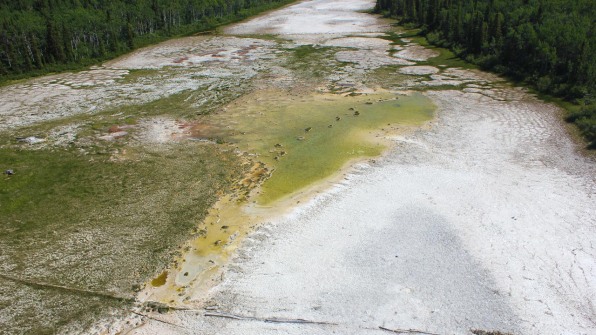In a field in northern British Columbia, a white mineral covering the ground–magnesite, also called magnesium carbonate–has slowly been sequestering CO2 from the atmosphere since the last ice age. That’s very helpful: We need to sequester more carbon. But the small crystals of the mineral, made by taking CO2 from the air, can take hundreds of thousands of years to grow, and we need fixes that work faster than that. In a Canadian lab, researchers recently demonstrated that they could speed up the process to 72 days.
It’s something that could potentially happen at a large scale to help fight climate change, since a metric ton of magnesite can capture half a metric ton of CO2 (the world emitted 32.5 gigatons of carbon in 2017). Other scientists have also experimented with other ways to speed up this type of “CO2 mineralization.” But while other processes often involve high heat and a lot of energy, the new process can happen at room temperature, so it should be cheaper.

“Other researchers have looked at forming this mineral using high-temperature, high-pressure reactors,” says Ian Power, an environmental geoscientist and professor at Trent University in Canada. “You can form this mineral quite quickly under those sorts of higher conditions. But higher temperature, higher pressure, usually means more energy input, which could ultimately be more expensive. That’s the real challenge with trying to sequester CO2 at a large scale–technologies do exist, we know how to do it, but trying to do it economically.”
In the lab, Power and his colleagues used a reactive surface with a negative charge that attracts positively-charged magnesium ions to speed up a part of the process of forming the mineral. In industrial reactors, the same process could potentially happen at a large scale. The process could potentially happen at power plants or other direct sources of pollution, or in the ocean, or it could possibly take CO2 from the air.
Some other approaches to capture CO2–for example, from the exhaust at a power plant–envision injecting it deep underground to store it, a process that risks leaks. Processes that form a mineral could be more secure. The mineral could be used for long-term storage or might be used in industry (magnesite is currently mined for some industrial uses).
Carbon capture and storage is a nascent field, particularly when it comes to technology that could sequester carbon directly from the atmosphere; the first commercial plant to directly suck CO2 from the air opened only last year, sitting on top of a waste incineration plant in Switzerland. But it’s the type of technology that the UN’s massive report on climate change says is necessary in most of the scenarios that it considers for how the planet can avoid catastrophic climate change.
Climate change is already here. Glacier National Park is on fire. In July, heat waves in the Arctic set off other unprecedented fires in Sweden, while extreme rainfall killed 200 people in Japan and displaced hundreds of thousands of people in Kenya. In South Africa, Cape Town teetered on the edge of running out of water in March. But to avoid an even more catastrophic future, the world needs to both keep moving to a zero-carbon economy and sequester CO2. Last year, the amount of carbon dioxide in the atmosphere tipped above 412 parts per million, higher than it has been in at least 800,000 years.
Bagikan Berita Ini














0 Response to "This carbon-sucking mineral could help slow down climate change"
Post a Comment